#are eusocial
Note
I am deathly afraid of wasps, but surely you’re not a hive of REAL wasps in my yard that would be silly
haha that would be so silly, right?
Anyways here's an image I took recently that you might be interested in.

#waspposting#wasps#wasp#that being said#most wasps are actually mostly solitary#only some#like hornets and yellow jackets#are eusocial#so if you come across a wasp hive#then it doesn't necessarily mean there are very many wasps living there
6 notes
·
View notes
Text
Reblogs = sample size etc etc
I'm aiming for informative, not funny - any context on how long is too long to bother watching would be nice as well so feel free to share in the tags
#youtube#twitch#scicomm#videos#video essays#my art#science#(context: im thinking about making a youtube channel again since all the informative videos about hiveminds are less than 5 minutes long)#(you cant even get into the drivers of eusociality in 5 minutes cmon)#but also i know i like my videos much longer than anyone else i know sooo
429 notes
·
View notes
Text
Wet Beast Wednesday: pistol shrimp
Oh snap, it's the snapping shrimp post for Wet Beast Wednesday! Snapping shrimp or pistol shrimp are loud little critters that have evolves a very useful and fascinating tool in their pincers. Let's not waste time and shoot off to learn about these little gunslingers.
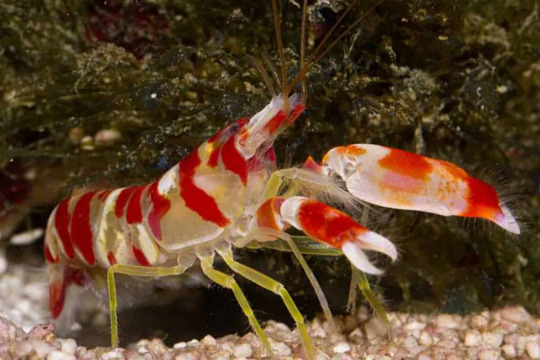
(Image: a pistol shrimp. It is a mostly white shrimp with red stripes. One of its claws is considerably larger than the other. It is standing on gravel and next to some seaweed. End ID)
Pistol shrimp are over 1,000 members of the family Alpheidae, which is part of the infraorder Caridea. This means they are true shrimp, not to be confused with superficially similar animals like brine shrimp, mantis shrimp, tadpole shrimp, and prawns. Yeah, I only recently learned that prawns and shrimp aren't a language difference between British English and American English like chips vs fries. They're not even that closely related. As true shrimp, pistol shrimp have two main body parts: the cephalothorax and abdomen, which are composed of 19 body segments. The abdomen forms a flexible tail with a fin on the end. When startled, the fin can rapidly curl under the body, propelling the shrimp backwards. Like other decapods, there are 10 limbs. The front pair of limbs have evolved into claws used to manipulate objects. The claws are the most distinguishing feature of pistol shrimp. They are asymmetrical, with one growing extremely large, over half the size of the body. The big claw has a modified version of the typical pincer. This pincer has an upper claw that can open up at a right angle. Under the claw is a pocket in the lower pincer, into which water flows. The upper pincer then slams down into this pocket, forcing the water out. The pressure of the pincer closing water in the pocket creates a cavitation bubble that is forced away from the claw at up to 26.8 meters per second. This is enough force to seriously wound small animals and hurt larger ones into leaving the shrimp alone. The cavitation bubbles can reach up to 4,427 degrees C (8,000 F) . For comparison, the surface of the sun is about 1,000 decrees (C) hotter. When the bubble pops, it creates a snapping sound that can reach 218 decibels. For comparison, most gunshots max out at around 170 db. This puts pistol shrimp is the running for the loudest ocean animals, with whales being the other main competitors. If that all sounds like a lot, the whole event happens so fast that the heat doesn't have time to affect much and the noise sounds like a moderately loud snap to us. Adults can snap their claws shut with an acceleration of up to 30 meters per second squared and juveniles can do it up to 20 times faster. The whole process takes less than a millisecond. When the cavitation bubble collapses, it can produce light. This is called sonoluminescence and nobody knows how it happens. If a pistol shrimp loses its large claw, the small claw will grow into a new large one while the missing limb will regenerate into a small claw. Adult pistol shrimp average between 3 and 5 cm long.
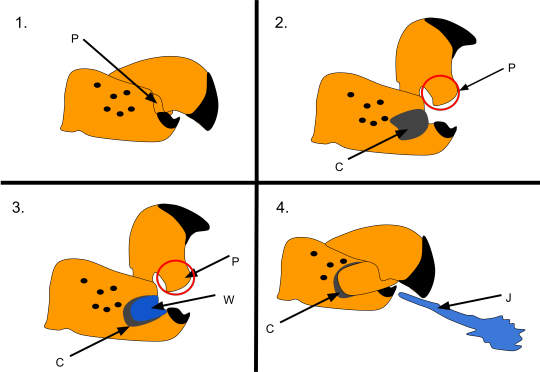
(Image: a drawing showing the process of a pistol shrimp snapping its claw. In the first panel, the claw is closed. In the second, the upper claw opens at a 90 degree angle, revealing a cavity. In the third panel, the cavity fills with water. In the final panel, the claw is closed again and a jet of water is ejected from the claw. End ID. Source: Wikipedia user Carermyers)
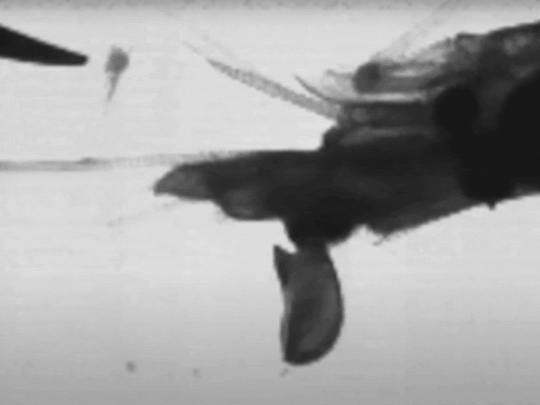
(Gif: black and white, slow-motion video of a pistol shrimp's claw snapping shut and creating a cavitation bubble. End ID. Source)
Pistol shrimp live worldwide, though most species live in tropical or temperate water. There are some cold water species and even freshwater species. Most prefer habitats where they can make burrows and where there are plenty of other animals. Coral reefs, oyster reefs, seagrass beds, mangrove groves are common habitats. Snapping is used for hunting and communication. They typically hide in burrows, waiting for fish or other small animals to pass by. When prey passes, the shrimp will snap to stun or seriously wound the prey, then drag it into the burrow. Some social species actually form eusocial hives with a single queen who produces all offspring. These shrimp are the only known marine eusocial species and all occur within the same genus (Synalpheus), though not every member of that genus is eusocial and eusociality appears to have evolved at least 3 times within that genus. It appears that a reason why only this genus developed eusociality is their larvae do not disperse, instead staying in the same area as the parents. The hives are usually located within sponges. Other social species are not eusocial, but still live together in colonies. Many less social species have formed a symbiotic relationship with gobies. Both species live in burrows, but gobies are bad at digging while the shrimp have poor eyesight. The goby will protect the shrimp while it digs a burrow, then the two live together. They will forage together, with the goby using its superior eyesight to watch for predators and warn the shrimp to get back to the burrow. Pistol shrimp are monogamous, the same pair coming back to mate over and over again (this does not apply to the eusocial species in which only the colony's queen is permitted to mate). The female is only fertile during a short period after molting. The male will stay with the female and protect her during the vulnerable period after mating and some species will remain with each other until the eggs hatch or permanently.
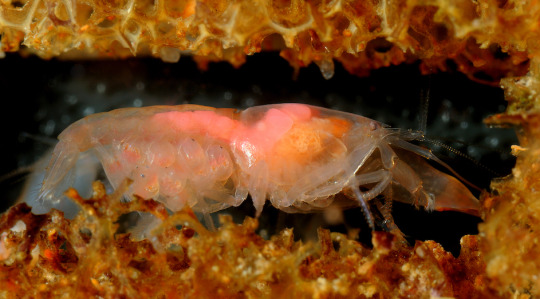
(Image: a eusocial pistol shrimp queen with eggs. Her body is translucent and multiple eggs are attached to her abdomen. The eggs look like translucent balls. The is inside of an orange sponge. End ID)
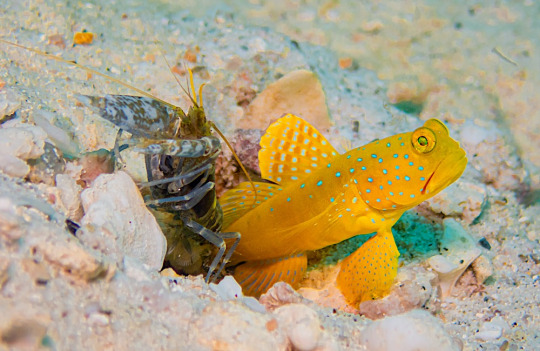
(Image: a pistol shrimp and goby emerging from a burrow in the sand. The shrimp is a mottled green and white. The body is a bright yellow fish covered with blue spots. End ID)
Pistol shrimp are a major source of noise in the places where they live. If you've ever been swimming and can hear repeated cracking noises, that may have been a bunch of pistol shrimp. Some scientists monitor the level of pistol shrimp noises as a method of monitoring the ecosystem. If the noise level drops, that is an indicator that the local ecosystem is suffering. The noise of the shrimps can get so loud that it actually interferes with sonar and forms of underwater communication. During World War II, members of the navy realized that the shrimp disrupted sonar enough to hide submarines, so they started hiding submarines near reefs with lots of the shrimp to keep them from being found by enemy subs. Weirdly not the only small marine animals to mess with submarines. I'll get the the other major one soon. The largest threats to pistol shrimp come from habitat destruction. Some species of pistol shrimp have entered the pet trade. As coral reefs, seagrass beds, and other habitats are destroyed, the shrimp that rely on them will suffer as well.

Yet another time I get to use one of these cards in a post
(Image: the Weird n' Wild Creatures card featuring pistol shrimp. End ID)
#wet beast wednesday#pistol shrimp#snapping shrimp#shrimp#decapod#crustaceans#marine biology#biology#zoology#ecology#animal facts#eusocial#symbiosis#goby#informative#image described
235 notes
·
View notes
Text
The Queen is Dead!
There is this tiresome old trope in any science fiction that deals with ants, (or aliens that are stand-ins for ants or termites or bees or any other eusocial insect,) where the queen dies and then, suddenly none of the workers can function anymore.
The workers in this theory of what a "hive mind" is are all just automata that extend the body of the queen. This is, of course, totally backwards.
It's the death of human queens that leaves their subjects disoriented.
We misperceive the order and smooth functioning of eusocial colonies for authoritarianism. No society could function so well without a tyrant, a single central mind, we assume. A great man or woman who drives their history must exist.
This is all human mythology applied to the alien world of ants.
What happens when the queen dies? Well let me tell you, because I've seen it happen... sadly.
Queens are the longest lived members of ant colonies. So, naturally if you keep ants, you grow attached to the queen. And it's true that without her the colony has no future in the long run for most species of ants (there are exceptions, who can gain new queens, or who have multiple queens... but most ant colony have but one) So, when the queen dies it's sad.
But, when she dies the workers ... keep going. You see the advantage of a "hive mind" isn't that there is one central node doing all the thinking, no, the colony is a distributed organism. And when the queen dies it's like menopause for a human body. There will be no new children. (though all eggs and larvae alive when the queen dies will be raised fully.) The ants without a queen continue to care for each other, continue to grow their fungus gardens, or heard aphids, they keep storing seeds and feeding the young.
With time, the last of the eggs and brood are raised to be adults. The nest is cleaned and tidy, everyone is fed, with all these tasks done the ants huddle together to conserve energy. They will keep tending the nest and eating when they need to... possibly for years. Menopause isn't the end of an individual life, it's just the closing of a particular door.
I do think ant colonies like this, like my own queen-less colony can seem a little sad. Eggs and larvae and pupae are such joys for ants. They lavish food and attention on their little sisters. No more little sisters means a less active colony, it's like winter has set in permanently. But ants live through winters. Sometimes many winters.
If you give a colony in this state brood from another queen they will raise them with great excitement. But there is no peaceful way to move the workers to a colony with a living queen.
This situation happens rarely in the wild. There are so many other things that can kill a colony long before a queen lives so long that she dies of old age.
In the wild there are also parasitic species of ants that look for colonies without a queen, or with a queen that is weak and easy to kill. These sneaky queen ants will "steal" a colony. Though, from the perspective of ants without a queen, this is almost a mercy.
But, there is none of this... everyone falling over and dying or everyone going crazy you see in stories about hives. The queen is just one part of the colony... a critical part... but still only a part.
And each individual ant still has her own life to live.
4K notes
·
View notes
Text
i love parasites so much. they are like the evolutionary biological equivalent of those minerals people find in the earth that are fantastical shapes and colors in terms of awe factor to me
71 notes
·
View notes
Note
I know yall have talked abt human be gones big bug sexuality and stuff, but what about gender? I feel like a lot of bugs have Weird Gender (ants, termites, wasps, bi-gendered moths/butterflies, etc) and I think it’s a cool topic to be discussed. Being a transgender bug sounds awesome

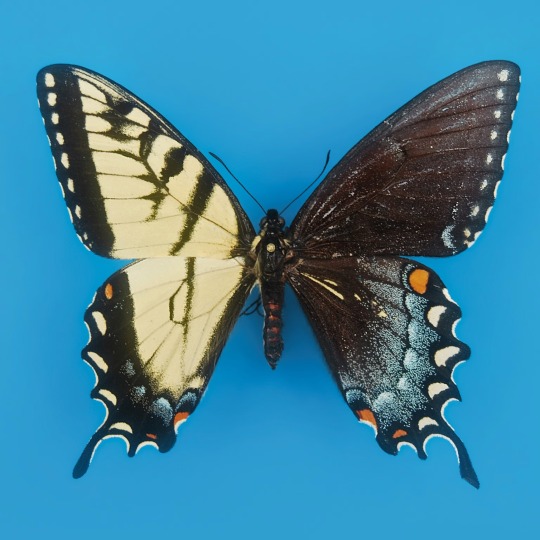
Macrovolute society is heavily influenced by eusocial hymenopterans. As a result, the common macrovolute word for "woman" is actually synonymous with "worker," whereas "prince/drone/male alate" is the same word as "man." (Yes, this caused a great deal of confusion when dealing with the termites and their male workers!)
Queens are seen as something *above* the common female. Not just one who can reproduce (as many worker ants technically can lay eggs that yield males), but one who can reproduce in a way that meaningfully contributes something (by reproducing en masse, living a ridiculously long time, and laying eggs that become useful queens and workers, instead of only largely useless males). Ants and other eusocial insects *do not* view the females of other species as queens--they view them as primitive workers, not yet advanced to totally ceding egg-laying!
The Swarm Mothers are the attempts of the non-eusocial insects to have something like a queen, but they are not the same thing.
As for everything else...well, we'll touch on it in time. ;)
39 notes
·
View notes
Note
Can I pick your brain for ideas lil bit? I'm working on a race of sapient subterranean eusocial arthropods and I can't decide on a biological basis for them. (I've already ruled the three most typical bases for this kind of fantasy guy; ants, wasps and mantids.)
I do however have a firm idea of their indigenous region; a massive biome of networked caves that support jungle-equivalent biodiversity via huge colonies of luminescent microbes that cling to the upper reaches of the caves. These arthropod folk live down here pretty exclusively, but they interact with other subterranean societies. I've also established tangentially that they've domesticated a large (described as 'dog sized') beetle whose larval form is used as livestock cause it produces an edible syrup as a waste product.
anyway I guess the actual question is do you have any ideas for which real world animals I could base these arthropod folk on; or unusual directions I could take the more typical bee/ant/mantis approach.
I don't suppose termites are an option? Something unusual I never see depicted about termites is that they have not only queens, but also kings! They're also unusual in that, unlike wasps, ants and bees (who strictly have female workers), there are also male workers!
If you're looking for more unusual eusocial insects, aphids and thrips are both options.
Like termites, eusocial thrips have both male and female workers. Unlike termites, the male "workers" can breed, however. (Female workers cannot; only special breeding females.) They also have soldiers with big mantis-like claws, which are used for crushing enemy thrips (as well as secreting antifungal compounds)! They all live together in galls (swellings they induce in host plants).
Some images of a species with different galls on different plants:

Some sources:
Eusocial aphids are unusual in that instead of having a single queen or just a few queens, the majority of the population is asexual females giving birth to clones. In some species, there are also (also female, though nonreproductive) soldiers. Some soldiers have turned the central tail spike into a stinger; others have wicked crablike forms like you can see on the right, compared to the more usual reproductive aphids on the left:
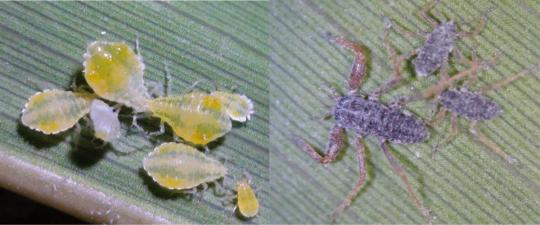
Some eusocial aphids live in galls, like the thrips. Others just live out in the open like usual aphids. Soldiers' duties range from keeping the gall clean (if they live in galls), to killing hoverfly maggots which prey on aphids.
At the end of the year, the aphids lay eggs that turn into winged males and females that breed, yielding the next year's asexual, wingless females again (both soldier and non-soldier).
Some sources:
Hope this helps!
40 notes
·
View notes
Text
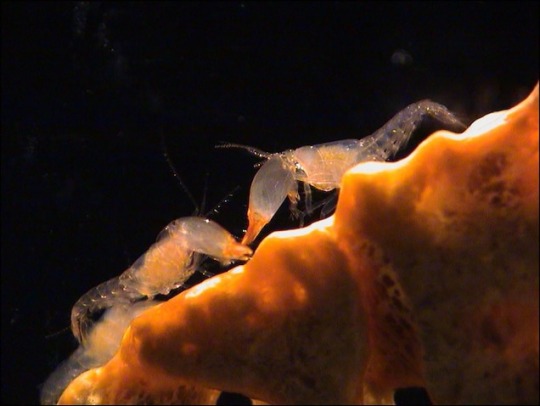



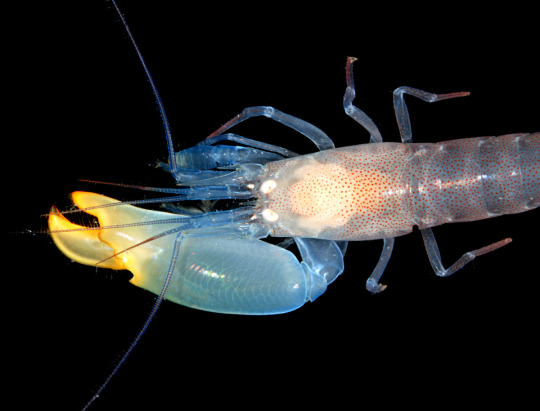
Synalpheus Regalis or Sponge-Dwelling Snapping Shrimp!
On land, we are all familiar with the eusocial behaviors of bees, but did you know that there is one genus of marine creatures that exhibit these same behaviors?
Sponge-dwelling snapping shrimp (aka pistol shrimp) are, according to Nat Geo, the bees of the sea! These tiny shrimp host the inside of sea sponges and live in colonies of about 300 members. The queen will reproduce while the eggs/babies are cared for by the colony. Guard shrimp also protect the queen and the colony from predators. This altruistic behavior exhibited by these shrimp is a strange and beautiful act that is continually being studied by scientists!
#shrimp#snapping shrimp#pistol shrimp#colony#sea sponge#beauty under the waves#sea#ocean#underwater#marine wildlife#ocean life#saltwater#marine creatures#sea creatures#sealife#animal#marine animal#marine biology#eusocial
385 notes
·
View notes
Text
Either tumblr's suggestion algorithm is so accurate and aggressive that they've pegged my interests immediately and are recommending content regarding Disco Elysium and Ultrakill and nothing else directly off the bat or my specific breed of autism is being spread in the water supply and all of you are infected
#disco elysium#ultrakill#I am patient zero for a disease that turns humans into a eusocial hivemind whose sole purpose is consuming specific pieces of content#long live the BeeMan colony
21 notes
·
View notes
Text

my stab at 'phantom dimensional rats'. based on real life aphids, which ants have been observed protecting and 'milking' for their sugary secretions. phantom dimension rats spawn candy, so phantoms (notoriously sweet-toothed) love them.
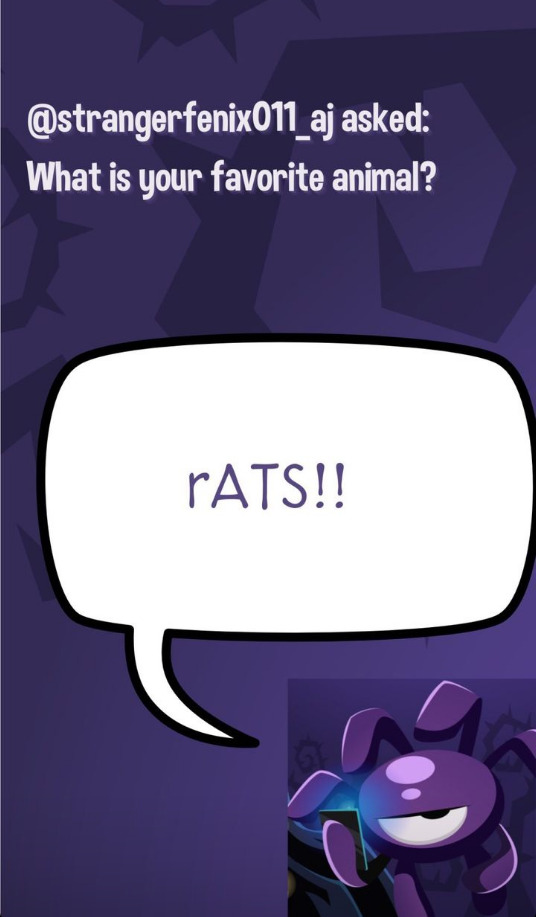

#talks#theres no particular reason my phantom lore is ants based i think phantoms are more just loose eusocial insectlike but i#happen to like ants so thats what youre getting.#animal jam
33 notes
·
View notes
Text
DARPA asked for proposals for insect-based AIs. Bug furries/monsterfuckers and robofuckers need to unite to completely sexualize this concept before they make it work
#CMON! YOU CAN DO IT!!#I'VE SEEN WHAT YOU PEOPLE DO WITH MILITARY ROBOTS!#AND I'VE SEEN WHAT YOU PEOPLE DO WITH EUSOCIAL INSECTS!#andi'dliketoseemoreplease#robotfucker#robophilia#monsterfucker#shitpost#geeeeeeeeh i have so much on my plate i dont wanna do it myself....
19 notes
·
View notes
Text
More types of bugs ought to be eusocial I think. It would be very cool.
I want to see what it would be like for mosquitos to try to store blood like bees store honey. I want to see swarms of lightningbugs as they leave to make a new nest. I want to see what a queen butterfly looks like.
12 notes
·
View notes
Text
Watching that one David Attenborough documentary, The Green Planet, and I really need to research leafcutter ants more because they feel like good [species that later became the Jem'Hadar] inspo
They farm fungi! And they receive chemical signals from the fungi that tell them what kind of leaves to gather to feed it!
That feels so much like what I had in mind for [species name currently redacted for Challengers Spoiler Reasons™] and their symbiotic relationship with the fungi that later became the basis for ketracel-white. I kind of love it.
(if you're wondering where "proto-Jem'Hadar were a eusocial species" comes from, I first wrote about it here)
8 notes
·
View notes
Text
For my masters thesis I will be introducing various eusocial societies to Marx. We're gonna get these working class ants, shrimp and naked mole rats unionized or die trying
18 notes
·
View notes
Text
im constantly thinking about how irkens are eusocial beings
#if you dont know what that means#think ants or bees or wasps even#eusocial just means functioning as one unit instead of individuals#my animal biology loving ass couldnt resist thinking abt shit like this#knotstalk#special interest#iz#invader zim
7 notes
·
View notes
Text
no parents: the seemingly paradoxical potential of a eusocial individual
(a rant about biology, philosophy, and various fictional societies from scifi settings)
first things first: when i talk about eusociality i mean it in the core biological sense of the word; it's a reproductive strategy. it's fundamentally about polymorphism within a single species, and the smallest of distinctions necessary is the distinction between reproductive and non-reproductive castes. the "ant queen". the "queen" is not a ruler; it's an egg-laying machine. the queen of a naked molerat burrow-complex holds no more inherent authority over "her" offspring than any other rodent matriarch would. each molerat is an individual. each ant, each termite, each bee, each sponge-symbiote shrimp.
the point im trying to emphasise is that im not talking about hiveminds here!!!
good? good.
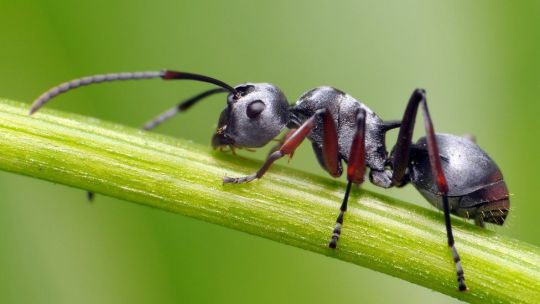
^an indidual
now with that out of the way:
-PART ONE: HUMAN APPROXIMATIONS
so, first of, examples of fictional societies of *humans* who switched their mode of reproduction to something akin or close to the eusocial "worker, queen, drone" template, though again, not all pieces are needed to "count"
1a: brave new world
starting off with an old scifi classic! BNW's society is interesting in just how it walks the tightrope between dystopia and utopia; to steal the term from isaac arthur, it's "post-discontent". every single individual is fully and completely human current day baseline-standards; a mortician wouldn't see a single strange thing about them. but they're all purpose *grown*. production-line wise, "our fordship be with us". it's production. no parents. all are free to do what they want. and they were made to do what they were made for. it's the culmination of a well-intentioned dream of fulfillment and efficiency.
the one factor to keep in mind is that technically speaking, *everyone* is still potentially reproductive. not in the mammalian reproduction way, but in the gene-donor for the hatcheries way. this detail does little to detract from the eusocial structure of the society.
individual-potential, there's actually very little to say! the entire thing is genuinely just shockingy *healthy* for each individual. and there are outliers! and there's also contingencies for outliers that are beneficial to said outliers. the new world does not limit. that would be cruel. and it is never cruel. the issue some of the outliers have is that it's *too* kind, in fact!
1b: tleilaxu
in contrast, the tleilaxu from the dune universe follow the structure of a eusocial organism almost to the letter. *almost*.
they're curious in how their incredible feats of society-shaping and biotechnology are all made in service to what ultimately amounts to an extreme form of fundamentalist zealotry. the culmination of the ultimate religious misogyny: "all tleilaxu women are queens", which, in the eusocial terminology, means they exist solely for reproduction.
on top of this, the majority of the tleilaxu population consists of completely sterile "face dancers" who are on the one hand still fully *people*, but simultaneously completely beholden to the orders of their masters on an instinctive level. orders given not in spoken language, but a complex inherent system of whistles and chemicals. like the pheromone trails of ants but more detailed.
and then there's the "masters". the *other* reproductive caste. they too are genetically modified to hell and back but on top of this keep simply regrowing themselves, in a twisted approximation of immortality. the ever-reborn rulers of their army of "growth tanks" and disposable face-dancer servants.
dune doesn't need aliens; given enough time to diverge, any human can become an alien.
and no individual can be an individual here. not at first at least. because there are still parents. the masters spoil the potential. they should've died long ago.
1c: krieg
yes, that krieg. from warhammer 40k. the trench WW1-larper guys. *insert shovel joke here*
but there's something there!
krieg is strange. you could argue the vita-womb born soldiers of the bombed-out shell of a hiveworld that is war-in-german are no different from say, clone troopers in star wars. except there's a massive difference under the hood; *krieg made and makes itself*. it's a society. the regiments of krieg are conscripted, sure, but they always send more than asked. they'd go out there unasked. they weren't made on order. they're a culture. a very distinct and purposeful one. and they no longer have the concept of a parent. a ruler, yes. a god too, in the great god-emperor of mankind. but each individual in the ranks of the underground cities of krieg is an individual. no parents, not an orphan.
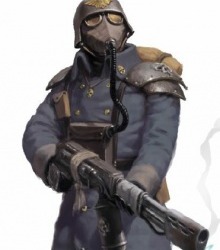
^one of the happiest people in the imperium, somehow
and an added quirk of krieg is the fact it's a eusocial outlier in an otherwise very much reproductively baseline greater imperium (give or take whatever goes on with servitors and on some forge worlds). which is something i genuinely know no other examples of in fiction (if you do let me know please!)
-PART TWO: INTRINSIC EUSOCIALITY (IT'S JUST HOMESTUCK AND VAST ERROR BUT TRUST ME ON THIS ONE)
you all knew this was coming! troll-time baby!
-2a: alternia
to understand troll reproduction i will *not* be going into quadrants; because funnily enough, interactions and relationships between individual *trolls* doesn't mean much for the complete picture. because trolls, funnily enough, occupy the same part of the "triangle" of eusocial phenotypes as the tleilaxu masters. not queens, not workers, but drones. (except troll workers are called drones because terminology is never straigth-forward!). or more accurately, 3 trolls are 1 drone, reproductively speaking.
that also explains the rampant intraspecific violence and other r-selected traits that seem out of place for a eusocial species, which are normally very good at caring for their offspring. except this does happen: to drones! because troll society is run *by drones* trolls fight and squabble and invent and the entire society and quite possibly troll sentience itself is a result of this rampant competition and sexual selection. ultra-individualists with no parents. a lusus isn't a parent, it doesn't have *expectations* beyond affection and food (though that last one can in itself be a huge issue: see spidermom and gl'golyb). but not a parent. a hive is a home. and ironically the straightforward stable ancient cruelty of alternia, though filled with mundane dread, is mercifully bereft of most existential dread. as is fitting for a society that evolved sapience in a post-scarcity environment.
almost the most individualistic eusocial society imaginable. almost.
(-2a*: beforus)
similar to alternia except in that past initial culling in the brood caverns the intraspecific violence is kept to an absolute minimu at the cost of very strong and paternalistic control. objectively a better place to live but it has a lot of issues and is arguably worse mentally for most. (beforus too has *issues*, they're just less in your face than alternia's, which is in itself part of the larger issue)
-2b: repiton
and at last, repiton my beloved outlier that does things to my perception and lives in my thinkpan rent-free, not that i ever ask rent.
repiton of the upside-down uncanny valley. the ex-post-scarcity society of eusocials keeping themselves going with mother grubs. without drones. ony trolls and almost-cloning. a species on permanent life-support. such an odd outlier, almost reminiscent of brave new world, but they got where they are from the other side of the growth tanks. the humans of brave new world could always go back to mammalian reproduction within a single generation, but the mother grubs are *gone*. it's barely eusocial at all anymore, just the remnants of it.
crumbled to the feudal ancap wasteland of desperation pretending to be freedom. the malaise of borrowed time.
end
im sorry i have no conclusion, only pent-up thoughts i wanted to share.
about brave new world and repiton as mirrors, written almost a century apart.
about krieg as the philosophically fascinating outlier it is.
about the difference between parent and lusus, and why i wish i grew up with the latter.
and about why a hivemind sucks all the interesting parts out of eusociality as a concept.
thanks to the single-digit amount of people reading all the way to the end.
#ak goes insane#very long post#eusociality#brave new world#dune#tleilaxu#death korps of krieg#40k#homestuck#alternia#beforus#vast error#repiton
42 notes
·
View notes